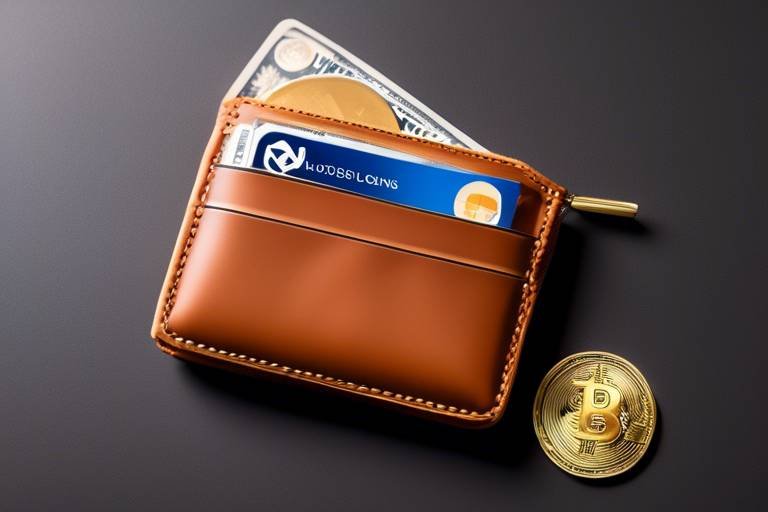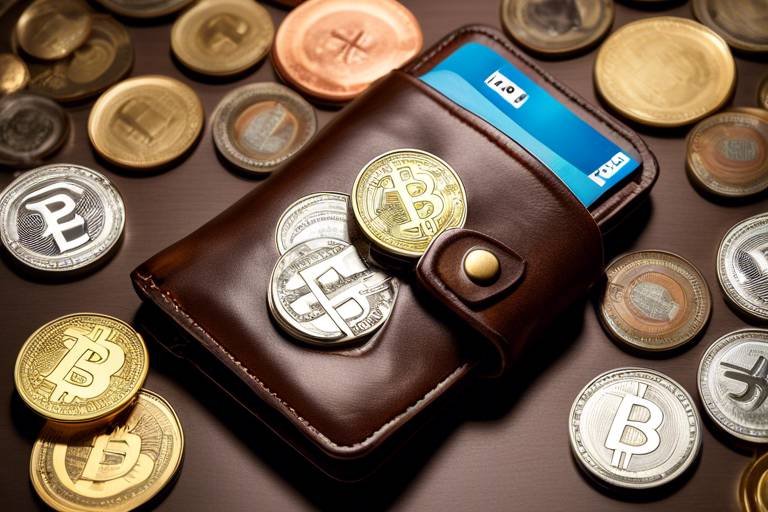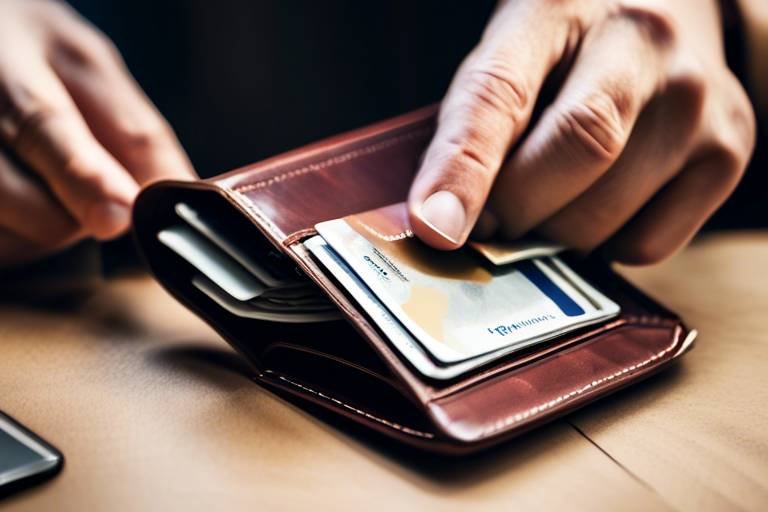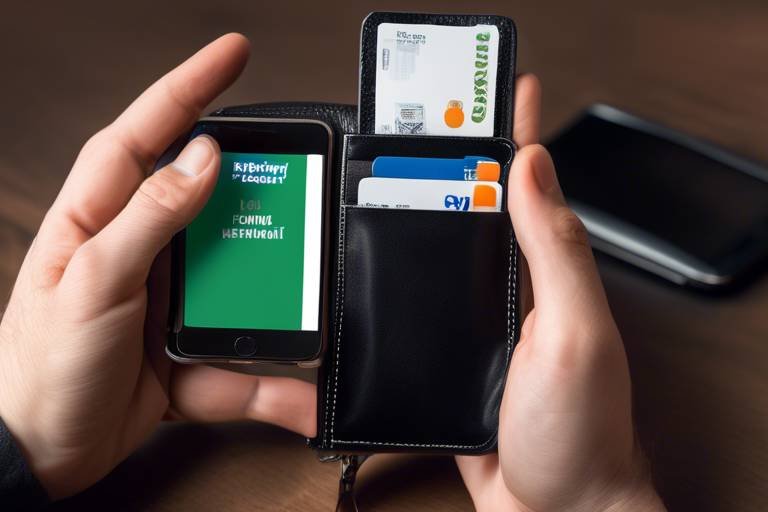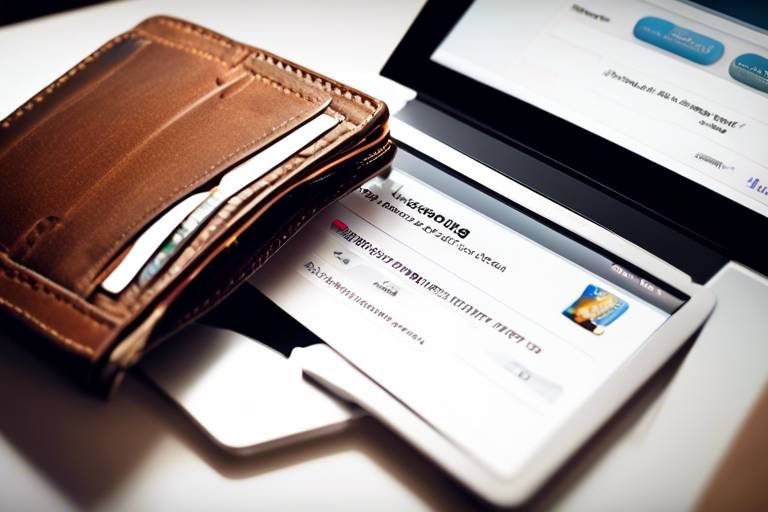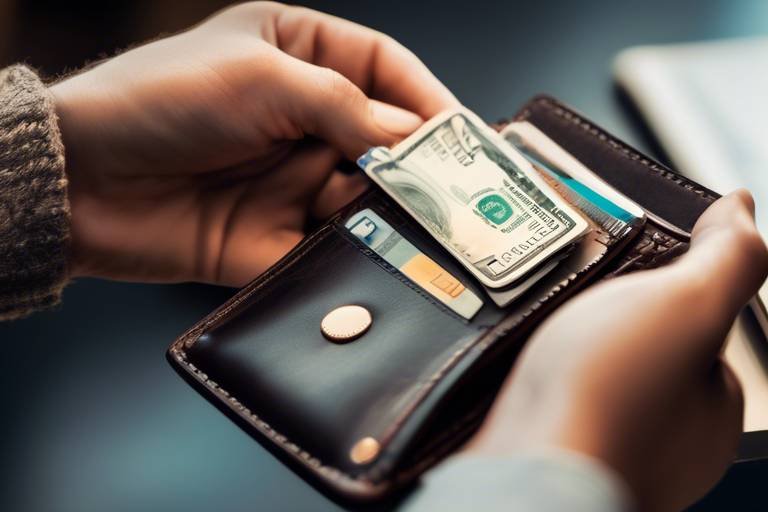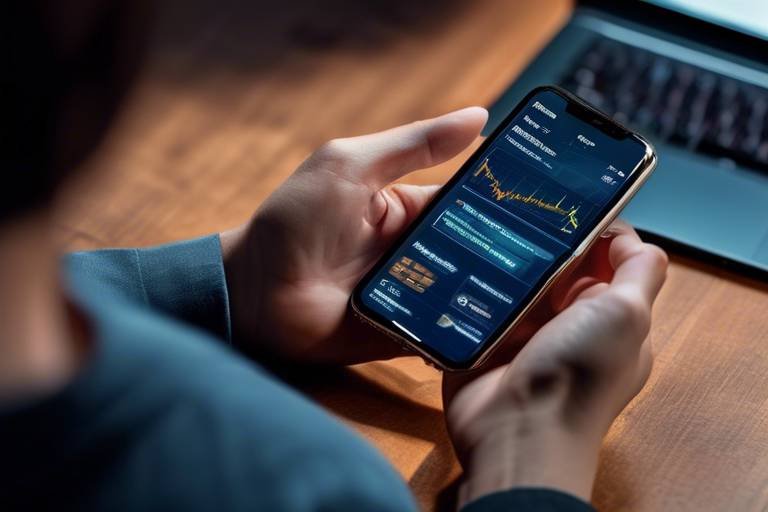The Future of Wallet Integration in Financial Technology
The world of financial technology is rapidly changing, and at the heart of this transformation is the concept of wallet integration. As we move into a future dominated by digital interactions, the way we manage our finances is evolving at an unprecedented pace. Have you ever thought about how much easier it is to make a payment with just a tap on your phone? This convenience is just the beginning. Wallet integration isn't just a trend; it's a fundamental shift in how consumers and businesses engage with money.
Imagine a scenario where your digital wallet not only holds your credit cards but also manages your loyalty points, tracks your spending, and even allows for seamless currency exchanges when traveling. This is the reality that wallet integration promises. As we dive deeper into this topic, we will explore how this integration is reshaping the financial landscape, making transactions faster, more secure, and incredibly user-friendly.
Moreover, as we look ahead, the implications of these changes extend beyond personal finance. Businesses are also reaping the benefits, as digital wallets streamline payment processes, reduce transaction times, and enhance customer experiences. But what does this mean for traditional banking services? Are they at risk of becoming obsolete? Or can they adapt and thrive alongside these new technologies? In this article, we will dissect these questions and more, providing a comprehensive overview of wallet integration's impact on consumers, businesses, and the economy as a whole.
As we venture further into the future, it becomes clear that the integration of wallets into financial technology is not just about convenience; it's about creating a more interconnected and efficient financial ecosystem. Buckle up as we explore the rise of digital wallets, the security challenges they face, and the innovative solutions paving the way for a secure and user-friendly experience!
Digital wallets have surged in popularity, offering convenience and security. This section discusses the factors driving their adoption and the impact on traditional banking services.
As wallet integration grows, so do security concerns. This part delves into the common threats faced by digital wallets and the innovative solutions being implemented to ensure user safety.
Fraud remains a significant issue in digital transactions. Here, we explore advanced techniques and technologies used to prevent fraud in wallet integrations.
Biometric authentication is becoming a standard in securing digital wallets. This section examines how fingerprint and facial recognition enhance security measures.
Encryption plays a crucial role in protecting user data. This part discusses the latest encryption technologies that safeguard transactions within digital wallets.
Regulatory frameworks are essential for wallet integration. This section highlights the importance of compliance and the challenges fintech companies face in adhering to regulations.
A seamless user experience is vital for wallet adoption. This section discusses the importance of intuitive design and user-friendly interfaces in enhancing customer satisfaction.
Customization features can significantly enhance user engagement. Here, we explore how personalization in digital wallets can cater to individual user needs and preferences.
Ensuring compatibility across various devices is crucial for wallet integration. This part examines the challenges and solutions in achieving cross-platform functionality for digital wallets.
The evolution of payment methods is closely tied to wallet integration. This section discusses emerging trends and technologies that will shape the future of payments in financial technology.
- What is wallet integration? Wallet integration refers to the process of merging various payment methods into a single digital wallet, allowing for streamlined transactions.
- Are digital wallets safe to use? Yes, digital wallets utilize advanced security measures, including encryption and biometric authentication, to protect user information.
- How will wallet integration impact traditional banking? While it may challenge traditional banking practices, many banks are adapting by incorporating digital wallet features to enhance customer experience.
- What trends should we expect in the future of wallet integration? We can expect increased personalization, enhanced security measures, and broader acceptance of digital wallets across various platforms.

The Rise of Digital Wallets
In recent years, digital wallets have experienced a meteoric rise in popularity, transforming how we handle our finances. Imagine carrying your entire wallet in your pocket, but instead of cash and cards, you have a sleek app that does it all. This convenience is driving a significant shift in consumer behavior, making digital wallets not just a trend but a staple in our daily lives. The ease of making transactions with a simple tap or click has made these wallets incredibly appealing to tech-savvy users who crave speed and efficiency.
Several factors contribute to the growing adoption of digital wallets. First and foremost is the increased smartphone penetration. With billions of people owning smartphones, the ability to access financial services at their fingertips has never been easier. Additionally, the ongoing global pandemic has accelerated the shift towards contactless payments, as consumers seek safer, hygienic ways to conduct transactions. Traditional banking services, once the cornerstone of financial transactions, are now being challenged to keep up with the rapid pace of digital innovation.
Moreover, the integration of loyalty programs and rewards within digital wallets adds another layer of appeal. Users can earn points, receive discounts, and enjoy personalized offers, all while managing their finances seamlessly. This fusion of convenience and value is enticing more consumers to make the switch from traditional payment methods to digital wallets.
However, the rise of digital wallets isn't just a boon for consumers; it also presents significant opportunities for businesses. Companies can leverage data analytics to understand consumer spending habits better, allowing for targeted marketing strategies that can increase customer engagement and retention. The ability to process transactions quickly and efficiently can also enhance the customer experience, leading to higher satisfaction rates.
To illustrate the impact of digital wallets, consider the following table that highlights the key benefits of adopting this technology:
| Benefit | Description |
|---|---|
| Convenience | Access to funds and payment options anytime, anywhere. |
| Security | Advanced encryption and authentication methods protect user data. |
| Loyalty Rewards | Integration of rewards programs enhances user engagement. |
| Speed | Instant transactions reduce waiting times at checkout. |
As we look to the future, it’s clear that digital wallets will continue to play a pivotal role in reshaping the financial landscape. With innovations like cryptocurrency integration and enhanced security measures on the horizon, the potential for growth and transformation in this space is limitless. So, are you ready to embrace the digital wallet revolution? The future of financial transactions is here, and it’s more exciting than ever!

Security Challenges and Solutions
As the integration of digital wallets into our daily lives continues to grow, so too do the security challenges that accompany this convenience. The digital landscape is a double-edged sword; while it offers unparalleled ease of use, it also exposes users to various risks. Identity theft, unauthorized transactions, and data breaches are just a few of the threats that can undermine the trust consumers place in these technologies. But fear not! Innovative solutions are emerging to combat these challenges, ensuring that digital wallets remain a safe and reliable option for users.
One of the most pressing concerns is the rise of fraud. The anonymity of online transactions can make it easier for malicious actors to exploit vulnerabilities. Common tactics include phishing scams, where users are tricked into revealing sensitive information, and malware attacks that compromise devices. To combat these threats, fintech companies are investing heavily in advanced fraud prevention techniques. For instance, artificial intelligence (AI) is being employed to analyze transaction patterns in real-time, flagging any suspicious activity before it can escalate into a full-blown crisis. This proactive approach is a game-changer, allowing companies to thwart fraud attempts before they affect consumers.
In addition to AI, biometric authentication is becoming a standard security measure in digital wallets. This technology leverages unique biological traits such as fingerprints and facial recognition to verify user identity. Imagine trying to unlock your wallet with just a glance! This not only enhances security but also simplifies the user experience. With biometric authentication, users can say goodbye to remembering complex passwords or PINs. Instead, they can access their funds with the touch of a finger or a simple smile. It's like having a personal bodyguard for your finances.
Another crucial aspect of securing digital wallets is the implementation of encryption technologies. Encryption transforms sensitive data into a code that can only be deciphered by authorized parties. This means that even if a hacker intercepts transaction data, it would be nearly impossible for them to make sense of it. Recent advancements in encryption methods, such as end-to-end encryption, ensure that user data remains confidential throughout the transaction process. It's akin to sending a locked box filled with treasures; only the intended recipient has the key to unlock it.
However, the road to secure wallet integration isn't without its bumps. Regulatory compliance plays a pivotal role in shaping the security landscape of digital wallets. Financial technology companies must navigate a complex web of regulations designed to protect consumers. This often involves adhering to stringent guidelines set forth by governing bodies, which can vary significantly from one jurisdiction to another. The challenge lies in ensuring that security measures meet these regulations while still providing a seamless user experience. Companies that successfully balance these demands will not only enhance security but also build consumer trust.
In conclusion, while the security challenges facing digital wallets are significant, they are not insurmountable. Through the adoption of advanced fraud prevention techniques, biometric authentication, and robust encryption technologies, fintech companies are paving the way for a safer digital payment landscape. As we move forward, the importance of regulatory compliance will continue to shape the security protocols in place, ensuring that users can enjoy the benefits of digital wallets without compromising their safety.
- What are the main security threats to digital wallets?
The main threats include identity theft, unauthorized transactions, and phishing scams. These risks can compromise user data and lead to financial loss.
- How does biometric authentication work?
Biometric authentication uses unique biological traits, such as fingerprints or facial recognition, to verify a user's identity, making it a secure and user-friendly option.
- What role does encryption play in digital wallet security?
Encryption protects sensitive data by transforming it into a coded format that can only be accessed by authorized parties, safeguarding transactions from potential hackers.
- Why is regulatory compliance important?
Regulatory compliance ensures that fintech companies adhere to laws designed to protect consumers, which helps to build trust and enhance security in digital transactions.

Fraud Prevention Techniques
In the fast-paced world of digital transactions, fraud prevention is a top priority for both consumers and fintech companies. With the rise of digital wallets, the landscape of financial technology has transformed, but so has the complexity of threats lurking in the shadows. Fraudsters are constantly evolving their tactics, making it crucial for companies to stay one step ahead. So, what are the most effective techniques for preventing fraud in wallet integrations? Let's dive into some of the advanced methods being employed.
One of the most effective strategies is the implementation of machine learning algorithms. These algorithms analyze transaction patterns in real-time, identifying anomalies that may indicate fraudulent activity. For instance, if a user typically makes small purchases and suddenly attempts a large transaction from a different geographical location, the system can flag this as suspicious and prompt additional verification steps. This proactive approach minimizes the risk of fraud before it can occur.
Another key technique involves multi-factor authentication (MFA). By requiring users to verify their identity through multiple means—such as a password, a text message code, or biometric data—companies can significantly reduce the chances of unauthorized access. This layered security not only protects users but also builds trust in digital wallet services. Imagine your wallet requiring not just a key but a fingerprint and a secret code before letting you in; that’s the kind of security we’re talking about!
Additionally, real-time transaction monitoring is essential. This technique involves continuously scanning transactions as they occur to detect and respond to fraudulent activities immediately. If a transaction is flagged, it can be paused, and the user can be notified to confirm whether they initiated it. This immediate response can prevent significant losses and protect user data.
Furthermore, fintech companies are increasingly adopting blockchain technology to enhance security. Blockchain provides a decentralized ledger that records all transactions transparently and securely. Each transaction is verified by multiple nodes, making it nearly impossible for fraudsters to alter the data without detection. As a result, users can have greater confidence in the integrity of their transactions.
Lastly, educating users about security practices is crucial. Many fraud attempts succeed due to user negligence, such as weak passwords or falling for phishing scams. By providing resources and tips on how to protect their accounts, companies can empower users to take an active role in their security. For instance, they might offer guidelines like:
- Using strong, unique passwords for each account.
- Regularly monitoring account statements for unauthorized transactions.
- Being cautious of unsolicited communications asking for personal information.
In conclusion, as digital wallets continue to gain traction, the importance of robust fraud prevention techniques cannot be overstated. By leveraging technology, implementing multi-layered security measures, and educating users, fintech companies can create a safer environment for digital transactions. The battle against fraud may be ongoing, but with these strategies in place, we can look forward to a more secure future in financial technology.
Q1: What is the most effective method for preventing fraud in digital wallets?
A1: While there is no single method that guarantees complete protection, a combination of machine learning algorithms, multi-factor authentication, and real-time transaction monitoring has proven to be very effective.
Q2: How does biometric authentication enhance security?
A2: Biometric authentication adds an extra layer of security by requiring unique physical characteristics, such as fingerprints or facial recognition, making it much harder for unauthorized users to gain access.
Q3: Can users do anything to protect themselves from fraud?
A3: Yes! Users should utilize strong passwords, monitor their accounts regularly, and be cautious of unsolicited requests for personal information.

Biometric Authentication
In today’s fast-paced digital world, has emerged as a game-changer in securing digital wallets. Imagine a world where you can access your financial information with just a glance or a touch. This is not science fiction; it’s the reality that biometric technologies bring to the table. Unlike traditional passwords, which can be forgotten or stolen, biometric data is unique to each individual, making it a robust solution for enhancing security.
Biometric authentication primarily includes methods like fingerprint recognition, facial recognition, and even iris scanning. These technologies are not only user-friendly but also incredibly effective in preventing unauthorized access. For instance, studies have shown that fingerprint scanners can reduce fraud by up to 90%, providing peace of mind for users who are increasingly concerned about the safety of their financial data.
Let’s dive deeper into how these methods work. Fingerprint recognition utilizes a sensor to capture the unique patterns of a person's fingerprint. This data is then encrypted and stored securely, ensuring that even if the data is intercepted, it remains unreadable. On the other hand, facial recognition uses advanced algorithms to analyze facial features, creating a digital map of the user’s face. This technology has gained traction in smartphones and is now making its way into digital wallets, enhancing security without compromising convenience.
However, while biometric authentication offers a myriad of benefits, it is not without its challenges. Privacy concerns loom large, as users may be hesitant to share their biometric data due to fears of misuse. Moreover, the technology itself must be foolproof; any errors in recognition could lead to frustrating user experiences. To combat these issues, companies are investing heavily in encryption technologies and secure data storage solutions, ensuring that biometric data remains protected at all costs.
In conclusion, the integration of biometric authentication in digital wallets not only enhances security but also improves the overall user experience. As we continue to embrace this technology, it’s crucial for companies to address the associated privacy concerns and invest in robust security measures. The future of wallet integration will likely see biometric authentication as a standard feature, paving the way for a more secure and user-friendly financial landscape.

Encryption Technologies
In today's digital landscape, where transactions occur at lightning speed, stand as the bulwark against potential threats to user data. Imagine encryption as a secret code that only you and your trusted contacts can understand. This technology transforms your sensitive information into an unreadable format, ensuring that even if cybercriminals intercept your data, they won't be able to decipher it. The importance of encryption in digital wallets cannot be overstated; it is the cornerstone of secure financial transactions.
One of the most prevalent forms of encryption used in digital wallets is Advanced Encryption Standard (AES). This symmetric encryption algorithm is widely recognized for its strength and efficiency. AES uses a key size of 128, 192, or 256 bits, making it incredibly difficult for unauthorized parties to crack. For instance, the higher the key size, the exponentially more difficult it becomes to break the encryption. This level of security is crucial, especially when dealing with sensitive financial information.
Another vital encryption technology is Transport Layer Security (TLS), which secures the communication between your device and the server hosting your digital wallet. Think of TLS as a secure tunnel through which your data travels. It protects against eavesdropping and tampering, providing a safe environment for your transactions. Without TLS, any data sent over the internet could be intercepted and misused, putting your financial information at risk.
Moreover, public key infrastructure (PKI) plays an essential role in establishing secure communications. PKI uses a pair of keys – a public key, which can be shared openly, and a private key, which is kept secret. This dual-key system ensures that even if someone gains access to the public key, they cannot decrypt the data without the private key. This technology is particularly useful in digital wallets, where secure identity verification is paramount.
However, as encryption technologies evolve, so do the methods employed by cybercriminals. The rise of quantum computing poses a potential threat to traditional encryption methods. Quantum computers have the potential to break many of the current encryption algorithms, leading to a race for developing quantum-resistant encryption. This new frontier in encryption technology aims to create algorithms that can withstand the power of quantum computing, ensuring the continued safety of digital wallets.
In conclusion, the landscape of encryption technologies is continuously evolving to meet the challenges posed by cyber threats. By leveraging advanced encryption standards, secure communication protocols, and innovative key management systems, digital wallets can provide users with the peace of mind they need when conducting financial transactions. As we move forward, it is crucial for both consumers and businesses to stay informed about these technologies to ensure their financial safety in an increasingly digital world.
- What is encryption in digital wallets?
Encryption in digital wallets refers to the process of converting sensitive information into a secure format, making it unreadable to unauthorized users.
- How does AES encryption work?
AES encryption uses a symmetric key to encrypt and decrypt data, with key sizes of 128, 192, or 256 bits, providing varying levels of security.
- What is the role of TLS in digital wallets?
TLS secures the communication between your device and the server, protecting your data from eavesdropping and tampering during transactions.
- What challenges does quantum computing pose for encryption?
Quantum computing has the potential to break traditional encryption methods, leading to the development of quantum-resistant algorithms to protect sensitive information.

Regulatory Compliance
In the rapidly evolving world of financial technology, has emerged as a cornerstone for the successful integration of digital wallets. As these wallets become more prevalent, they must navigate a complex landscape of regulations designed to protect consumers and ensure the integrity of financial systems. The challenge lies not only in understanding these regulations but also in implementing them effectively without stifling innovation.
To illustrate the importance of regulatory compliance, consider the various laws and guidelines that govern financial transactions. These include anti-money laundering (AML) regulations, know your customer (KYC) requirements, and data protection laws such as the General Data Protection Regulation (GDPR) in Europe. Each of these frameworks plays a crucial role in maintaining trust and security in digital transactions. Businesses that fail to comply risk heavy penalties, loss of reputation, and, ultimately, the trust of their customers.
Moreover, the regulatory landscape is constantly changing. Governments and regulatory bodies are continually updating their rules to keep pace with technological advancements. For instance, the rise of cryptocurrencies and decentralized finance (DeFi) has prompted regulators to rethink existing frameworks. This means that fintech companies, especially those involved in wallet integration, must stay ahead of the curve and adapt to new regulations promptly.
One of the significant challenges fintech companies face is ensuring compliance across different jurisdictions. Since regulations can vary widely from one country to another, companies that operate internationally must navigate a patchwork of rules. This can lead to increased operational costs and complexity. To address this issue, many companies are investing in compliance technology, which uses artificial intelligence and machine learning to streamline the compliance process. These technologies can analyze vast amounts of data to ensure adherence to regulations, making compliance more efficient and less prone to human error.
In addition to technology, collaboration with regulatory bodies is essential. Engaging in proactive dialogue can help fintech companies understand regulatory expectations and contribute to the development of new guidelines that support innovation while protecting consumers. This collaborative approach is vital in creating a regulatory environment that fosters growth in the financial technology sector.
As we look to the future, the importance of regulatory compliance in wallet integration cannot be overstated. Companies that prioritize compliance will not only mitigate risks but also build stronger relationships with their users. Trust is a currency of its own in the digital age, and those who can demonstrate a commitment to regulatory adherence will likely stand out in a crowded market.
In summary, regulatory compliance serves as both a challenge and an opportunity for businesses involved in wallet integration. By embracing compliance as a fundamental aspect of their operations, fintech companies can position themselves for long-term success in a rapidly changing landscape.
- What is regulatory compliance in financial technology? Regulatory compliance refers to the adherence to laws and regulations that govern financial transactions and protect consumers in the fintech industry.
- Why is compliance important for digital wallets? Compliance is crucial for digital wallets to ensure security, build trust with users, and avoid legal penalties.
- How can fintech companies stay compliant? Companies can stay compliant by investing in compliance technology, engaging with regulatory bodies, and continuously updating their knowledge of regulations.
- What are some common regulatory challenges in wallet integration? Common challenges include varying regulations across jurisdictions, keeping up with changing laws, and ensuring data protection.

User Experience and Interface Design
In the fast-paced world of financial technology, user experience (UX) and interface design play pivotal roles in determining the success of digital wallets. Imagine walking into a store where the layout is confusing, the staff is unhelpful, and the checkout process is a nightmare. Frustrating, right? Now, translate that experience to a digital wallet. If users find it cumbersome or unintuitive, they are likely to abandon it faster than you can say "transaction."
One of the primary goals of effective UX design is to create an intuitive experience that guides users effortlessly through their financial transactions. This means that every button, every swipe, and every notification should feel natural and instinctive. A well-designed interface can significantly enhance customer satisfaction, leading to higher adoption rates and increased usage. For instance, consider how popular apps like Venmo and PayPal have streamlined their interfaces to minimize friction during transactions, making it easier for users to send and receive money.
Moreover, the importance of visual hierarchy cannot be overstated. Users should be able to quickly identify crucial elements on the screen, such as their balance, transaction history, and payment options. By using contrasting colors, sizes, and spacing, designers can create a layout that naturally draws the user's attention to the most important information. This approach not only improves usability but also fosters trust in the application, as users feel more in control of their financial data.
Another critical aspect of UX design is feedback mechanisms. When users perform an action, such as making a payment or updating their profile, they should receive immediate and clear feedback. This could be in the form of a confirmation message, a visual cue, or even a subtle sound. Without these indicators, users may feel uncertain about whether their actions were successful, leading to confusion and potential errors.
To further enhance user engagement, many digital wallets are integrating customization and personalization features. Imagine being able to tailor your wallet to reflect your preferences—choosing your favorite color scheme, setting up quick access to frequently used features, or even receiving personalized offers based on your spending habits. These elements not only make the wallet feel more personal but also encourage users to interact with the app more frequently.
Cross-platform compatibility is another significant consideration in interface design. Users expect to access their digital wallets seamlessly across various devices—be it their smartphone, tablet, or desktop. This means that designers must ensure that the experience is consistent and functional, regardless of the platform. Achieving this can be challenging, but it is essential for maintaining user trust and satisfaction.
In conclusion, the design of user experience and interface in digital wallets is not just about aesthetics; it’s about creating a holistic experience that meets users' needs while ensuring security and functionality. As the landscape of financial technology continues to evolve, the emphasis on UX and interface design will only grow, making it a critical factor for success in the competitive world of digital wallets.
- What is user experience design in financial technology? User experience design focuses on creating intuitive and enjoyable interactions for users when they engage with digital products, such as wallets.
- Why is interface design important for digital wallets? A well-designed interface enhances usability, increases customer satisfaction, and encourages user adoption and retention.
- How can personalization improve user engagement? Personalization allows users to tailor their experience, making the app feel more relevant and user-friendly, which can lead to increased usage.
- What are some challenges in cross-platform compatibility? Ensuring that an app functions seamlessly across different devices can be complex, requiring careful design and testing.

Customization and Personalization
In the digital age, where every user seeks a unique experience, customization and personalization have become the cornerstones of digital wallet adoption. Imagine walking into a store where every item is tailored just for you—sounds appealing, right? That's the kind of experience users expect from their digital wallets today. The ability to personalize a wallet not only enhances user engagement but also builds a sense of ownership and loyalty. With features that allow users to customize their interfaces, notifications, and even transaction categories, digital wallets are morphing into personal finance assistants that cater to individual needs.
One of the most significant aspects of personalization in digital wallets is the ability to tailor financial insights and recommendations. For instance, users can receive tailored offers based on their spending habits, which can lead to better financial decisions. Imagine getting a notification suggesting a discount on your favorite coffee shop just because you've frequented it often. This level of personalization makes users feel valued and understood, fostering a deeper connection with the wallet service.
Furthermore, customization extends beyond mere aesthetics. Users can select their preferred payment methods, set spending limits, and categorize expenses according to their lifestyle. This kind of flexibility allows users to create a wallet experience that aligns with their financial goals. For example, a user focused on saving might opt to receive alerts when they exceed a set budget, while another user might prioritize cashback offers on specific categories like groceries or entertainment.
To illustrate the impact of customization and personalization, consider the following table that showcases various features that digital wallets can offer:
| Feature | Description | Benefit |
|---|---|---|
| Custom Themes | Users can choose colors and layouts that resonate with their personal style. | Enhances user experience and satisfaction. |
| Spending Insights | Visual representations of spending habits over time. | Helps users make informed financial decisions. |
| Personalized Offers | Offers based on user spending patterns and preferences. | Encourages user loyalty and increases wallet usage. |
| Transaction Categorization | Ability to categorize transactions for better tracking. | Improves financial management and awareness. |
Moreover, the integration of AI and machine learning into digital wallets is paving the way for even more sophisticated personalization options. These technologies analyze user behavior, predict future spending, and suggest tailored financial products or services. For example, if a user frequently travels, the wallet could offer travel insurance or currency exchange services, making the experience not only convenient but also highly relevant.
In conclusion, customization and personalization are not just optional features in digital wallets; they are essential components that can significantly enhance user experience. As the fintech landscape evolves, we can expect to see even more innovative approaches to tailoring digital wallets to individual preferences, making them indispensable tools in our financial lives.
- What is the difference between customization and personalization in digital wallets?
Customization refers to the ability to modify the wallet's appearance and settings, while personalization involves tailoring the wallet's features and recommendations based on individual user behavior. - How does personalization improve user experience?
Personalization enhances user experience by providing relevant offers, insights, and features that align with individual financial habits and preferences. - Are there any security concerns with customization?
While customization enhances user experience, it's crucial to ensure that security measures are in place to protect personal data and financial information.

Cross-Platform Compatibility
In today's fast-paced digital landscape, has emerged as a critical factor for the success of digital wallets. Imagine a world where you can seamlessly transition from your smartphone to your tablet, or even your laptop, without missing a beat in your financial transactions. This is the reality that consumers are increasingly demanding, and it’s a challenge that fintech companies must rise to meet.
As users adopt digital wallets, they expect to access their funds and make transactions across multiple devices effortlessly. However, achieving this level of compatibility is no small feat. Different operating systems, device specifications, and user interfaces can create significant hurdles. For instance, a wallet that performs flawlessly on Android may face compatibility issues on iOS, potentially alienating a segment of users. Thus, fintech companies are investing heavily in developing solutions that ensure a smooth experience across various platforms.
One approach to enhancing cross-platform compatibility is through the use of cloud-based services. By storing user data and wallet information in the cloud, companies can allow users to access their wallets from any device with an internet connection. This not only provides convenience but also ensures that users have the latest updates and features at their fingertips. Furthermore, cloud services can facilitate real-time synchronization, meaning that any changes made on one device are instantly reflected on all others.
Another important aspect is the user interface (UI) design. A wallet that looks and feels the same across all devices enhances user trust and familiarity. Fintech companies are now focusing on creating responsive designs that adapt to different screen sizes and resolutions, ensuring that users have a consistent experience whether they are on a phone, tablet, or desktop. This reduces the learning curve for new users and encourages existing users to engage more with the wallet.
However, the journey toward perfect cross-platform compatibility is not without its challenges. Security remains a top concern, as integrating multiple platforms can expose vulnerabilities. Companies must ensure that their security protocols are robust enough to protect user data across all devices. Additionally, maintaining performance and speed is crucial; users expect their wallets to operate smoothly without lag, regardless of the device they are using.
To illustrate the importance of cross-platform compatibility, consider the following table that outlines the key benefits and challenges:
| Benefits | Challenges |
|---|---|
|
|
In conclusion, cross-platform compatibility is more than just a nice-to-have feature; it’s a necessity in the evolving world of digital wallets. As consumers continue to embrace technology in their financial transactions, the pressure on fintech companies to deliver seamless, secure, and user-friendly experiences across all devices will only intensify. By prioritizing compatibility, these companies can not only enhance customer satisfaction but also position themselves as leaders in the competitive financial technology landscape.
Q: What is cross-platform compatibility?
A: Cross-platform compatibility refers to the ability of a digital wallet to function seamlessly across various devices and operating systems, allowing users to access their accounts and perform transactions without any limitations.
Q: Why is cross-platform compatibility important for digital wallets?
A: It is essential because users expect to manage their finances on multiple devices. Ensuring compatibility enhances user satisfaction, increases engagement, and broadens the wallet's market reach.
Q: What challenges do companies face in achieving cross-platform compatibility?
A: Companies face challenges such as maintaining security, ensuring consistent performance, and creating a uniform user interface across different devices and operating systems.

The Future of Payment Methods
As we look to the horizon of financial technology, it's clear that the future of payment methods is not just about convenience; it's about creating an ecosystem that integrates seamlessly into our daily lives. Imagine a world where your wallet is not just a physical object but a digital extension of yourself, capable of handling all transactions with a simple tap or scan. This is not science fiction; it's the reality that digital wallets and advanced payment methods are forging for us.
One of the most exciting trends is the rise of contactless payments. With the proliferation of NFC (Near Field Communication) technology, consumers can now make transactions by simply waving their smartphones or smartwatches near a payment terminal. This shift is not merely about speed; it's about redefining how we interact with money. The convenience of contactless payments cannot be overstated, especially in a fast-paced world where every second counts. But what does this mean for traditional payment methods? Are they on the verge of extinction? Not quite.
While digital wallets and contactless payments are gaining traction, traditional payment methods like cash and credit cards are still very much alive. It's more about coexistence than replacement. In fact, many consumers appreciate having options. For instance, in regions where digital infrastructure is still developing, cash remains king. However, as financial literacy improves and technology becomes more accessible, we can expect a gradual shift towards digital solutions.
Moreover, the integration of cryptocurrency into payment methods is another game-changer. As more businesses begin to accept cryptocurrencies like Bitcoin and Ethereum, consumers are given an alternative that promises lower transaction fees and enhanced privacy. This could potentially disrupt the traditional banking system, pushing it to innovate and adapt to the changing landscape. However, the volatility of cryptocurrencies poses challenges that need to be addressed before they can become mainstream.
Another critical aspect of the future of payments is the role of artificial intelligence (AI) and machine learning. These technologies are not only enhancing security but also personalizing the payment experience. Imagine receiving tailored offers and promotions based on your spending habits, all while ensuring that your transactions are secure and fraud-proof. AI can analyze vast amounts of data to detect unusual patterns, alerting users to potential fraud in real-time. This level of personalization and security is set to redefine consumer expectations.
As we navigate this evolving landscape, it’s essential to consider the regulatory implications of these advancements. Governments around the world are grappling with how to regulate digital currencies and payment systems without stifling innovation. Striking the right balance will be crucial in fostering a safe and efficient payment ecosystem. Compliance with regulations will not only protect consumers but also build trust in these new payment methods.
In conclusion, the future of payment methods is a thrilling journey filled with possibilities. From the rise of digital wallets and contactless payments to the integration of cryptocurrencies and AI, we are on the brink of a financial revolution. The key will be to embrace these changes while ensuring security and compliance, paving the way for a more inclusive and efficient financial future.
- What are digital wallets? Digital wallets are applications or software that allow users to store payment information and make transactions electronically.
- Are contactless payments safe? Yes, contactless payments use encryption and tokenization to protect your financial information, making them a secure option.
- How does cryptocurrency work as a payment method? Cryptocurrency operates on blockchain technology, allowing for secure and transparent transactions without the need for traditional banks.
- What role does AI play in payment methods? AI helps enhance security by analyzing transaction data for fraud detection and can also personalize user experiences based on spending habits.
Frequently Asked Questions
- What are digital wallets and why are they becoming popular?
Digital wallets are electronic applications that allow users to store and manage their payment information securely. They are gaining popularity due to their convenience, enhanced security features, and the ability to streamline transactions. With the rise of e-commerce and mobile payments, more people are turning to digital wallets for quick and easy transactions.
- How do digital wallets enhance security for users?
Digital wallets enhance security through various measures such as encryption, biometric authentication, and fraud detection technologies. These features help protect users' sensitive information and ensure that transactions are safe from unauthorized access.
- What are some common security challenges faced by digital wallets?
Common security challenges include phishing attacks, unauthorized access, and data breaches. As digital wallets become more prevalent, cybercriminals are developing sophisticated methods to exploit vulnerabilities, making it crucial for users and providers to stay vigilant and adopt effective security measures.
- What is biometric authentication and how does it work?
Biometric authentication uses unique physical characteristics, such as fingerprints or facial recognition, to verify a user's identity. This method adds an extra layer of security, making it significantly harder for unauthorized users to access digital wallets.
- How does encryption protect transactions in digital wallets?
Encryption transforms sensitive data into a coded format that can only be read by authorized parties. In digital wallets, encryption safeguards users' payment information during transactions, ensuring that even if data is intercepted, it remains unreadable to cybercriminals.
- Why is regulatory compliance important for digital wallets?
Regulatory compliance is essential to ensure that digital wallets operate within legal frameworks, protecting users and maintaining trust in the financial system. Compliance helps prevent fraud, money laundering, and other illicit activities, fostering a safer environment for all users.
- How can user experience impact the adoption of digital wallets?
A seamless user experience is critical for the adoption of digital wallets. If users find the interface confusing or cumbersome, they are less likely to use the wallet regularly. Intuitive design and user-friendly features can significantly enhance customer satisfaction and encourage more people to embrace digital payments.
- What role does customization play in digital wallets?
Customization allows users to tailor their digital wallet experience to their preferences, such as setting up personalized alerts or organizing payment methods. This level of personalization can enhance user engagement and satisfaction, making digital wallets more appealing.
- Why is cross-platform compatibility important for digital wallets?
Cross-platform compatibility ensures that digital wallets can be accessed and used across various devices and operating systems. This flexibility is crucial for user convenience, as it allows individuals to make transactions anytime, anywhere, regardless of the device they are using.
- What future trends should we expect in wallet integration?
Future trends in wallet integration may include the increased use of artificial intelligence for fraud detection, enhanced personalization features, and the integration of cryptocurrencies. As technology continues to evolve, we can expect digital wallets to become even more versatile and secure, shaping the future of financial transactions.




